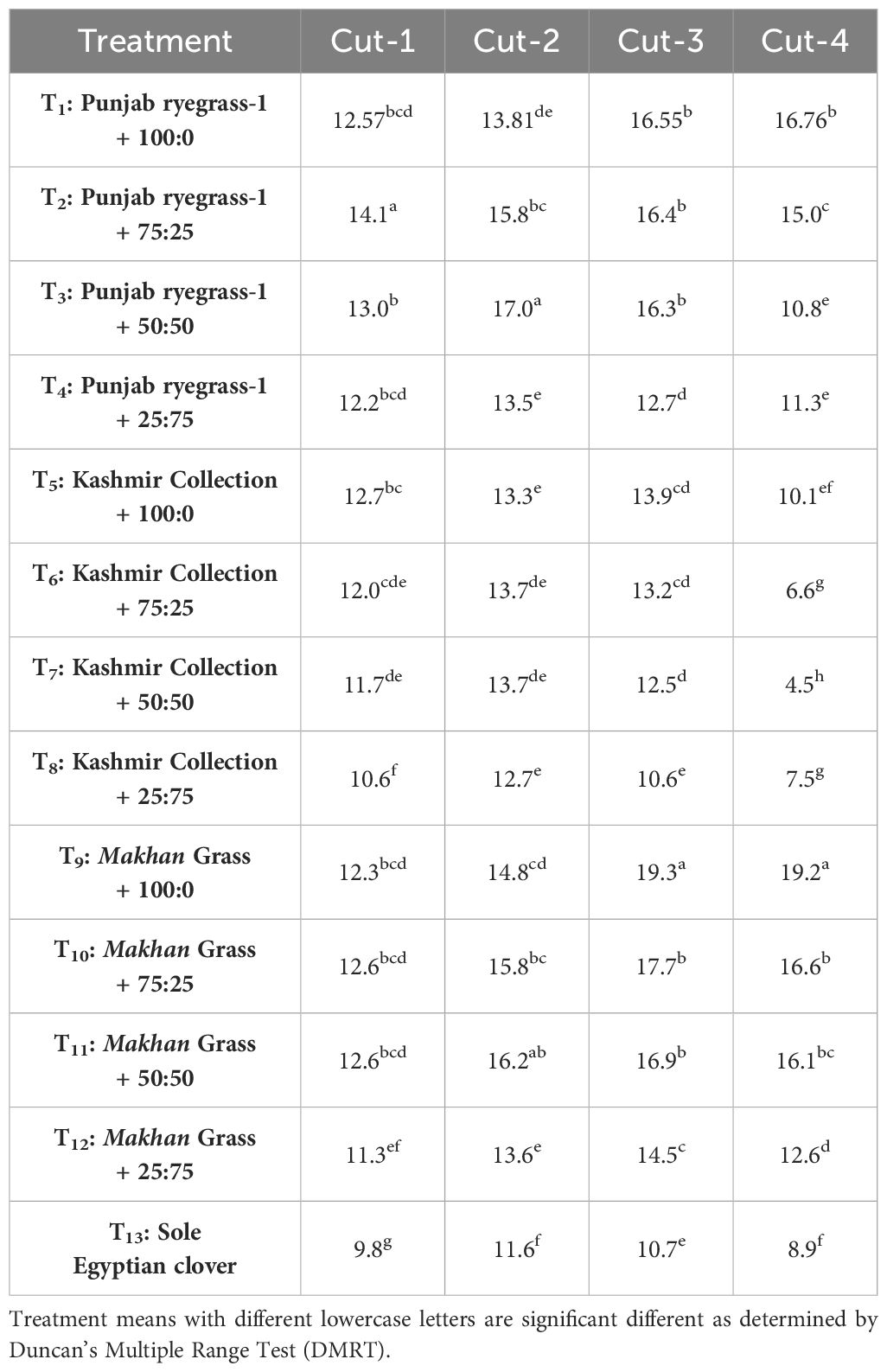- 1Department of Agronomy, Chaudhary Sarwan Kumar Himachal Pradesh Krishi Vishvavidyalaya, Palampur, India
- 2Project Coordination Unit, All India Coordinated Research Project on Forage Crops, ICAR–Indian Grassland and Fodder Research Institute, Jhansi, Uttar Pradesh, India
- 3National Agricultural Higher Education Project (NAHEP) - Centre of Advanced Agricultural Science & Technology (CAAST), Chaudhary Sarwan Kumar Himachal Pradesh Krishi Vishvavidyalaya, Palampur, India
The scarcity of high-quality forage has a significant influence on the productivity and profitability of livestock. Addressing this concern, an investigation was undertaken to assess the effects of distinct Italian ryegrass genotypes, namely, Punjab ryegrass-1, Kashmir collection, and Makhan grass, in conjunction with varying seeding ratios of Italian ryegrass to Egyptian clover. The seeding ratios considered were 100:0 (Italian ryegrass to Egyptian clover), 75:25, 50:50, and 25:75. All possible combinations of Italian ryegrass and Egyptian clover with seeding ratios were set up in a randomized complete block design and replicated thrice. Co-cultivating Italian ryegrass and Egyptian clover at a 75:25 seeding ratio yields the best yield benefit, as determined by the land equivalent ratio. It is noteworthy that in this configuration, real yield loss is higher for Egyptian clover and for Italian ryegrass when the seeding ratio is 25:75. The higher competitiveness of Italian ryegrass in comparison to Egyptian clover is highlighted by the competitive ratio. Notably, the nutritive parameter, crude protein yield, was significantly higher in the Makhan grass-based 50:50 and 75:25 seeding ratio. Results of the study ascertained the compatibility of grass-legume co-cultivation with significantly higher quantity and quality forage harvested under mixed cropping systems whereas Makhan grass as the superior and dominant genotype in comparison to Kashmir collection. The outcomes of this study revealed that the 100:0 seeding ratio, coupled with the Makhan grass genotype, exhibited superior performance in terms of cumulative forage harvest, dry matter accumulation, net returns, and benefit–cost ratio.
1 Introduction
Italian ryegrass (Lolium multiflorum Lam.), a winter forage grass of Southern Europe, is cultivated throughout Australia, North America, Europe, and New Zealand as a short-lived grass for its great digestibility and palatability (Lithourgidis et al., 2006). Being farmed across the temperate zones of the world, Italian ryegrass is a very productive and nutritive grass that is capable of soil conservation and is particularly excellent for waterlogged soils (Hannaway et al., 1999; Gerdes et al., 2005; Meena et al., 2017; Salama, 2020). Wider adaptability and capability to produce greater quantities of quality forage biomass makes Italian ryegrass a better candidate for mixed cropping systems along with legumes (Thalooth et al., 2015). Several desirable characteristics such as quick establishment, suitability for reduced tillage, and nutritional multicuts make Italian ryegrass a preferable winter forage crop (Meena et al., 2017).
Egyptian clover (Trifolium alexandrinum), a native of Western Asia, is an annual leguminous forage crop frequently planted in the southern United States and nations with moderate winters, such as India, Egypt, Turkey, and Pakistan (Pecetti et al., 2012). With its restorative character and vast adaptability across diverse soil types, including soils with salinity and alkalinity concerns, its cultivation is being encouraged to such soils where commercial crop cultivation meets a slew of challenges. Cattle breeding and milk production are inextricably tied with forage production. Winter is the most restricted season, with less green forage available for the animals. Egyptian clover is used for both seed and forage, as well as a multifunctional forage crop in the winter, producing green forage, hay, and silage (Tufail et al., 2020; Abuzaid et al., 2021). Because of its great nutritional content, the crop is a key component of the animal diet. It has a high concentration of crude protein (15.8%–26.7%), crude fiber (14.9%–28.3%), calcium (1.4%–2.58%), nitrogen (2.52%–4.25%), and phosphorus (0.14%–0.20%) (Devi, 2019). Egyptian clover is a popular forage crop among farmers worldwide due to its multicut nature, great palatability, ability to fix atmospheric nitrogen, and rapid development (Tufail et al., 2020; Jabbar et al., 2022). In the face of climate change, the crop has high water requirements as well as susceptibility to temperature changes (Salama, 2020).
In addition to increasing animal production, mixed cropping is a great way to address the wintertime forage deficit (Meena et al., 2017). It is among the effective strategies that may generate high-quality food while using less resources sustainably. Legumes and grasses in cropping combinations provide forage mixtures with increased protein and fiber concentration, improving their nutritional value (Ansar et al., 2010). Aside from improving nutritive value, feed mixes are said to increase fodder consumption (Ansar et al., 2010). Combining forage legumes with annual grasses creates an optimal cropping system with characteristics such as complementary growth habit, high biomass, high protein, fiber, improved rhizosphere-based microbial activity, and minimal input demand (Rakeih et al., 2008; Salama, 2020). Forage-legume-based mixed cropping systems offer high production and resource usage efficiency due to their diverse ability to utilize resources efficiently such as light, water, and nutrients (Lithourgidis et al., 2006; Atis et al., 2012). Such cropping systems are far less vulnerable to insect and plant invasions, as well as weather changes that are common in monocultures (Lithourgidis et al., 2011). Yucel et al. (2018) proposed Italian (annual) Ryegrass–Egyptian clover mixed cropping systems as a potential choice for excellent forage production with substantially higher quality forage production with 60% Egyptian clover and 40% annual ryegrass-based mixture. Magda et al. (2021) studied the Egyptian clover–annual ryegrass-based intercropping systems along with the influence of nitrogen fertilizers on such systems and found that a 75:25-based sowing proportion of annual ryegrass and Egyptian clover was the best in terms of forage harvest and nutritive value. Rady et al. (2022) studied the Egyptian clover-based monoculture systems as well as intercropping systems with grasses including triticale, ryegrass, barley, and oats and observed better forage harvests and nutritive value for grass–legume-based intercropping systems.
Mixing ratios are a key determinant of the nutritive value and harvest that may be obtained from forage-legume-based mixed cropping systems due to the competitive nature of grasses compared to legumes. Italian ryegrass genotypes differ in their growth behavior and dominance over component crops, which might have a substantial impact on Egyptian clover’s growth capacity. Keeping in consideration the variable response of Egyptian clover and annual ryegrass at variable sowing proportions and differential growth ability of Italian ryegrass genotypes and their dominance over component crops, the present long-term field experiment was designed with an aim to evaluate and recommend Italian ryegrass genotypes and corresponding seeding ratios for enhanced forage harvest and optimized nutritive value in cropping mixtures with Egyptian clover. The objectives of the experiment were to ascertain forage harvests, assess their nutritive value, analyze competition involved among crops, and evaluate the economic benefits and soil fertility implications.
2 Materials and methods
A 4-year field experiment was conducted at Fodder Farm, Department of Genetics and Plant Breeding of Chaudhary Sarwan Kumar Himachal Pradesh Krishi Vishvavidyalaya, Palampur, India during the winter season from 2014 to 2018. The experiment began on 17 October 2014 and ended on 19 April 2018.
The Palampur region of Himachal Pradesh (HP), India, falls under the sub-temperate humid zone of HP, which is characterized by mild summers and cool winters. The experimental site lies between 32°6´N and 76°3´E at an elevation of 1,200 m AMSL (Above mean sea level). The soil at the experimental site was acidic in reaction (pH = 5.4), medium in organic carbon (0.68%), low in available nitrogen (217 kg/ha), and medium in available phosphorus (12 kg/ha) and available potassium (236 kg/ha).
Randomized complete block design (RCBD) was applied to the experiment wherein the experimental field was divided into three blocks that served as replicates. Each block was divided into 13 treatments wherein all possible combinations of three genotypes of Italian ryegrass and the four seeding ratios with the Egyptian clover along with the sole stand of Egyptian Clover were randomly allocated using random number table. The treatments consisted of Italian ryegrass genotypes, viz., Punjab ryegrass-1, Kashmir collection, and Makhan grass and four seeding ratios for Italian ryegrass: Egyptian clover (100:0, 75:25, 50:50, and 25:75) and the sole stand of broadcasted Egyptian clover. Makhan grass was being tested for release in the state of Himachal Pradesh, whereas the Kashmir collection and Punjab ryegrass-1 were the standard checks for the Makhan grass genotype. The Makhan grass genotype has been known to have a plant height ranging from 10 to 40 cm along with rapid-growing, high forage-producing capacity and crude protein concentration highly suitable for most of the livestock classes (Tiwari et al., 2023). Punjab ryegrass-1, on the other hand, a multicut genotype of annual ryegrass, had an average forage harvest yield of 32.5 Mg/ha along with the presence of soft stems and leaves in its biomass (Kushwaha and Singh, 2023). The Egyptian clover variety used was Mescavi.
Traditional tillage procedures were practiced before sowing the crop seeds as per the experimental treatments. Italian ryegrass was sown at a rate of 15 kg/ha, whereas Egyptian clover was sown at a rate of 25 kg/ha. Application of nutrients, such as nitrogen:phosphorus:potassium, using urea (46% nitrogen), single super phosphate (16% phosphorus), and muriate of potash (60% potassium), was applied at a rate of 120:60:40 kg/ha when Italian ryegrass was grown as the sole or component crop, and at a rate of 20:60:40 kg/ha when Egyptian clover was used as the sole crop. At the time of sowing half of the recommended nitrogen, full dose of phosphorus and potassium were applied as basal dose in both sole ryegrass and berseem cropping as well as in their intercropping systems. The remaining nitrogen was split into four portions each applied 30 days after sowing (DAS) and at first cut, second cut, and third cut, respectively. Irrigation and weed management practices were maintained uniformly for all the plots. For irrigation (pre-sowing irrigation + four irrigations per season) and weed management (single time), the surface method and the hand weeding method were practiced every season.
2.1 Sampling and measurements
2.1.1 Total forage harvest and dry matter accumulation
Four cuttings, the first at 78 DAS, the second at 108 DAS, the third at 143 DAS, and the fourth at 183 DAS, were sampled from the different treatments. With a field stubble of 10 cm, the plants were trimmed using stainless steel sickles. Biomass from the entire plot was gathered for green forage, discarding the plot’s border rows. The total forage harvest was derived with the summation of forage harvest obtained for each cut. Single forage harvest value for each cut was derived by averaging the total forage harvest obtained each cut each year with number of years. The dry matter accumulated was determined by taking a 100-g sample of fresh green forage from the net plot area, air-drying it for 3–4 days, and then oven-drying it at 105°C in a hot air oven to achieve a consistent weight. Total dry matter accumulation was derived using the same procedure as green forage harvest.
2.1.2 Crude protein concentration and crude protein yield
The samples were further ground in a stainless-steel-based grinder to a particle size of 1 mm for nutritive analysis. The nutrient concentration of plant samples was determined using standard procedure for nitrogen concentration (Jackson, 1973). The crude protein content was obtained by multiplying nitrogen concentration with a factor of 6.25. Subsequently, crude protein yield was obtained by using the following formula:
2.1.3 Soil analysis
The soil samples were collected at the end of each season with auger from 0- to 15-cm soil depth and taken to the laboratory for drying, and for further processing and analysis. The soil organic carbon and available nitrogen were determined using standard procedures for organic carbon, available nitrogen, potassium, and phosphorus, i.e., wet digestion method (Walkley and Black, 1934), alkaline permanganate method (Subbiah and Asija, 1956), neutral normal ammonium acetate extraction method (Black, 1965), and Olsen’s method (Olsen et al., 1954), respectively.
2.1.4 Competitive indices
2.1.4.1 Land equivalent ratio
Land equivalent ratio (LER) defines the efficiency of cropping mixtures in utilizing environmental resources efficiently (Mead and Willey, 1980). LER can be derived as given below (Rady, 2016):
where Y (ECIR) = yield of Egyptian clover as an intercrop in Italian ryegrass, Y (IREC) = yield of Italian ryegrass as an intercrop in Egyptian clover, Y (EC) = yield of Egyptian clover as a sole crop, and Y (IR) = yield of Italian ryegrass as a sole crop.
A value of 1 is critical in assessing LER; when it is greater than 1, then the cropping mixture favors the growth and productivity of mixing partners, and when it is less than 1, there is a negative impact over growth and productivity of mixing partners in that cropping mixture.
2.1.4.2 Competitive ratio
Competitive ratio (CR) describes the competition occurring between crop species involved in a particular cropping mixture (Willey and Rao, 1980). It defines the competitive ability of involved crop species and is an advantageous alternative to aggressivity. CR can be derived based on the equation below (Rady, 2016):
2.1.4.3 Relative crowding coefficient
Relative crowding coefficient (K) is basically an index to measure the relative dominance of one crop species over another in a cropping mixture (De Wit, 1960). It can be calculated using the equation given below (Rady, 2016):
where Z (IREC) = seeding proportion of Italian ryegrass in mixture and Z (ECIR) = seeding proportion of Egyptian clover in mixture.
Interpretation for relative crowding coefficient values can be assigned as follows:
When the value of [K (Egyptian clover) * K (Italian ryegrass)] is greater than 1, then there is a yield advantage; when it is less than 1, there is a disadvantage; and when it is equal to 1, there is a disadvantage or advantage.
2.1.4.4 Actual yield loss
Actual yield loss (AYL) has been known to be a precise and efficient index to define the competition between and within component crops more accurately. It describes the behavior of the component crops in a particular cropping mixture as it takes into consideration the actual sown proportion and yield as pure and intercrops for participating crops. AYL can be derived based on the equation below (Banik, 1996):
Values of AYL can be positive or negative, signifying yield advantage or disadvantage for component crops.
2.2 Economic benefits
Net returns were derived by subtracting gross returns from the total cost of cultivation. The equation for which is given below:
Benefit–cost ratio was derived by dividing gross returns by cost of cultivation for which the equation is given below:
2.3 Data analysis
The dataset derived from both field and laboratory analyses were scrutinized by the analysis of variance technique within the framework of an RCBD. The 4-year data were subjected to homogeneity test of variance using Bartlett’s Chi-square test as prescribed by Gomez and Gomez in 1984. The Chi-square test was non-significant; therefore, the data were pooled over years without any transformation. The R packages “ggplot2” (Wickham, 2016), “agricolae” (Felipe, De, 2009), “dplyr” (Wickham et al., 2023), and “gridextra” (Auguie and Antonov, 2017) were utilized in data analysis and visualization, ensuring a comprehensive understanding of the obtained results. Significant treatment variations were assessed with a stringent threshold of a 5% level of significance (p = 0.05), adhering to established statistical protocols. Additionally, a correlation heat map was created, to study the correlation between the various yield parameters and competitive indices, using R-software. The R packages “ggplot2” (Wickham, 2016) for visualization of correlation heatmap and “GGally” (Schloerke et al., 2024) for calculating correlations were used (R Core Team, 2023).
3 Results
3.1 Green forage and dry matter accumulation harvested
Green forage harvested at various cuts was significantly influenced under the influence of annual ryegrass genotypes and the seeding ratios of Egyptian clover and annual ryegrass genotypes (Table 1). The initial harvest yield exhibited a marked increase in treatments employing Punjab ryegrass-1 at a seeding ratio of 75:25, followed closely by those utilizing a 50:50 seeding ratio of the same variety. The latter treatment demonstrated statistical parity with those incorporating the Makhan grass genotype at seeding ratios of 75:25, 50:50, and 100:0, as well as with the Kashmir collection at 100:0 seeding ratio. During the second cut, a significantly higher forage harvest was recorded with Punjab ryegrass-1 (50:50) followed by Punjab ryegrass-1 (75:25) and Makhan grass with seeding ratios of 50:50, and 75:25. A significantly higher forage harvest in third cut was recorded in treatments using Makhan grass at a seeding ratio of 100:0, followed by those with a seeding ratio of 75:25, and 50:50 of the same genotype and also with Punjab ryegrass-1 with seeding ratios of 100:0, 75:25, and 50:50. A comparable trend was recorded during the final cut of Italian ryegrass genotypes in combination with Egyptian clover at varied seeding ratios. During the different cuts, significantly lower forage harvest was recorded where the sole stand of Egyptian clover was cultivated.
Similarly, the total amount of forage harvested and dry matter accumulation were strongly influenced by the combination of Egyptian clover and several genotypes of Italian ryegrass under varying seeding ratios. The total amount of forage harvested and dry matter accumulated ranged from 40.96 to 65.61 Mg/ha and 7.24 to 13.95 Mg/ha, respectively. The sole stand of Italian ryegrass genotype, Makhan grass was proved to be the most productive with significantly higher dry matter and forage harvest produced i.e., 13.95 and 65.61 Mg/ha. Makhan grass did perform the best across the experimental years (2014–2018) with significantly higher green forage harvests and dry matter accumulation as compared to other sole stands as well as forage mixtures (Tables 2, 3). Among forage mixtures, co-cultivating Egyptian clover and Makhan grass at seeding ratios of 75:25 produced significant equivalent results to cultivation of Makhan grass alone. Similar stable and consistent results with a forage mixture of Egyptian clover and Makhan grass at seeding ratios of 75:25 especially in terms of green forage harvest were observed across the experimental study from 2014 to 2018 (Table 3). Punjab ryegrass-1 did perform good with at par dry matter accumulation for the sole stand of Punjab ryegrass-1 (12.76 Mg/ha), whereas in terms of total forage harvest, it performed second best when sown at a ratio of 75:25 (61.23 Mg/ha) with Egyptian clover.
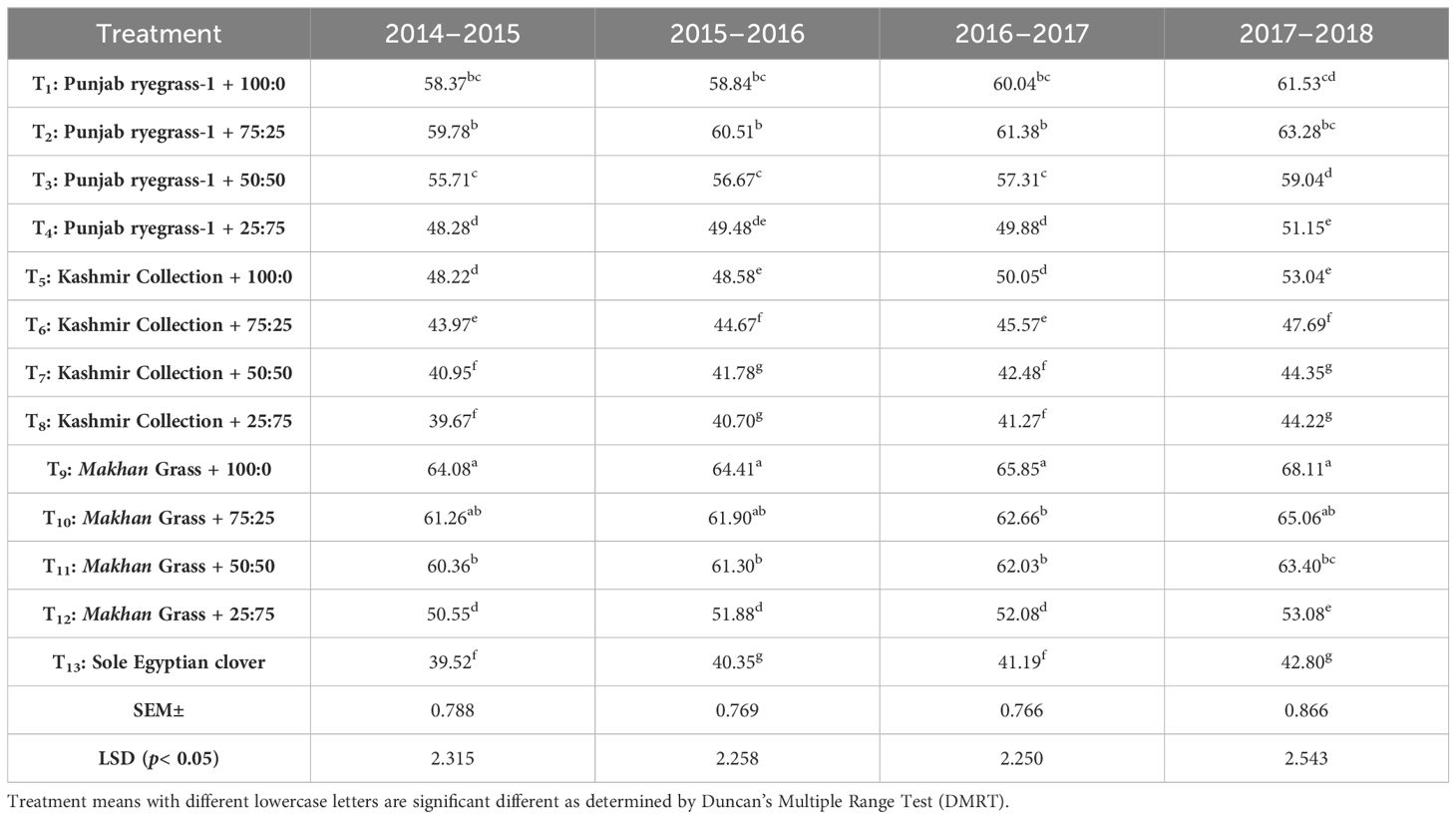
Table 2 Effect of seeding ratios and Italian ryegrass genotypes on forage harvest from 2014 to 2018.
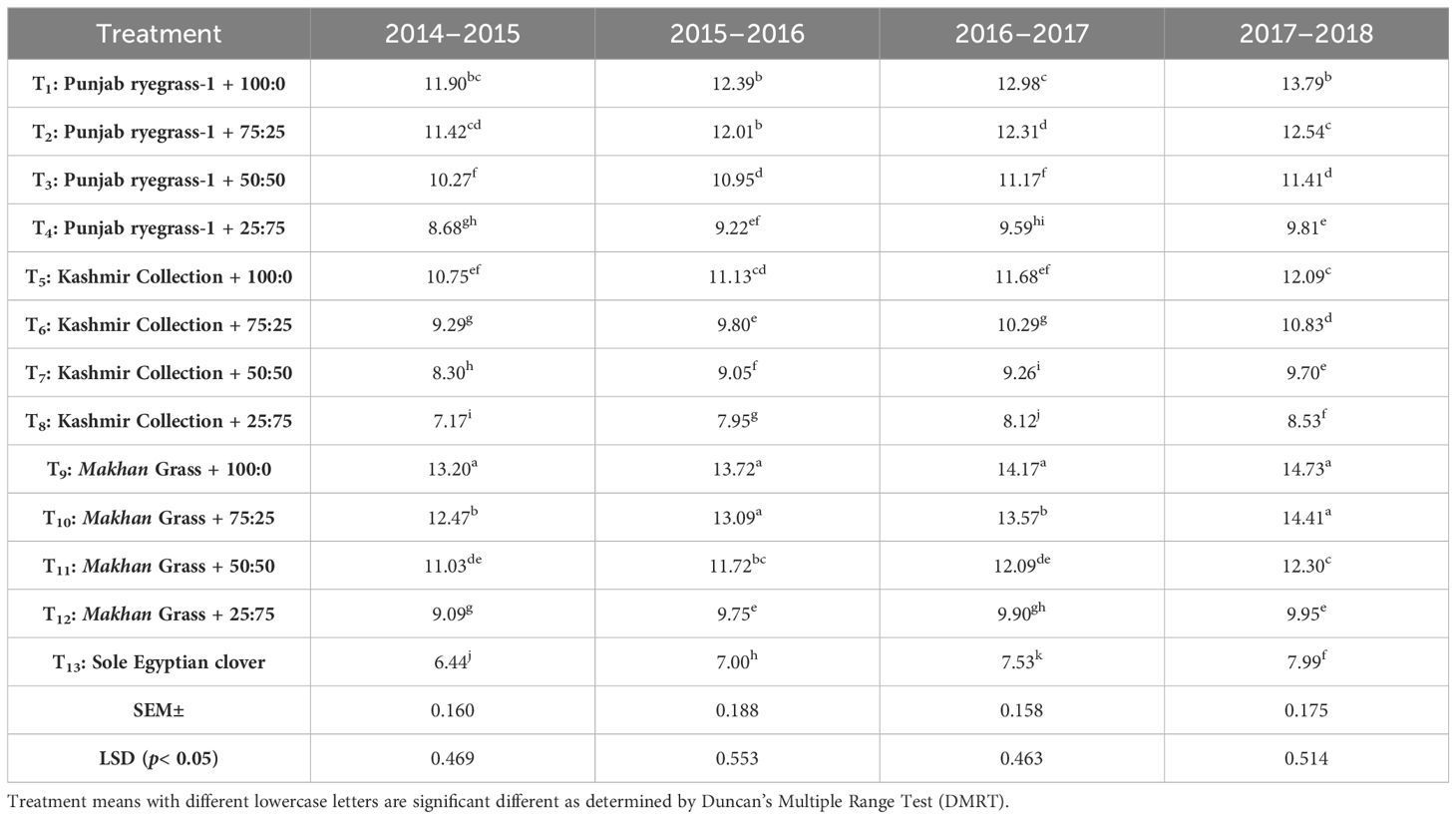
Table 3 Effect of seeding ratios and Italian ryegrass genotypes on dry matter accumulation from 2014 to 2018.
3.2 Crude protein concentration and yield
The analysis of crude protein concentration revealed a spectrum spanning from 11.37% to 19.83%. A markedly elevated crude protein concentration of 19.83% was notably discerned in the sole stand of Egyptian clover. The sole stand of Egyptian clover performed similarly across the experimental years from 2014 to 2018 in terms of crude protein concentration (Table 4). Concurrently, combinations featuring Egyptian clover in higher proportions, specifically in the seeding ratios of Punjab ryegrass-1 (25:75) and Makhan grass (25:75), exhibited heightened crude protein concentration, reaching 18.08% subsequent to the sole stand of Egyptian clover. Conversely, the lowest crude protein concentration was noted in the sole stand of Kashmir collection at 11.37%, a figure statistically at par with the sole stand of the Punjab ryegrass-1 (11.66%) genotype of Italian ryegrass. The performance of the sole stand of the Kashmir collection genotype was consistently poor for all the experimental years, i.e., from 2014 to 2018 (Table 5). Although the crude protein concentration was the highest in the sole cultivation of Egyptian clover, a significantly elevated crude protein yield of 1.92 Mg/ha was evident in the combination of Makhan grass and Egyptian clover at a seeding ratio of 50:50. This combination performed consistently better across the experimental years (2014–2018). This outcome was statistically at par with the same combination at seeding ratios of 75:25 (1.91 Mg/ha) and 25:75 (1.75 Mg/ha) (Table 6). Conversely, the combination of Kashmir collection and Egyptian clover at a seeding ratio of 75:25 yielded the lowest crude protein of 1.26 Mg/ha. This outcome was statistically at par with the sole cultivation of the Kashmir collection, which exhibited a crude protein yield of 1.29 Mg/ha.
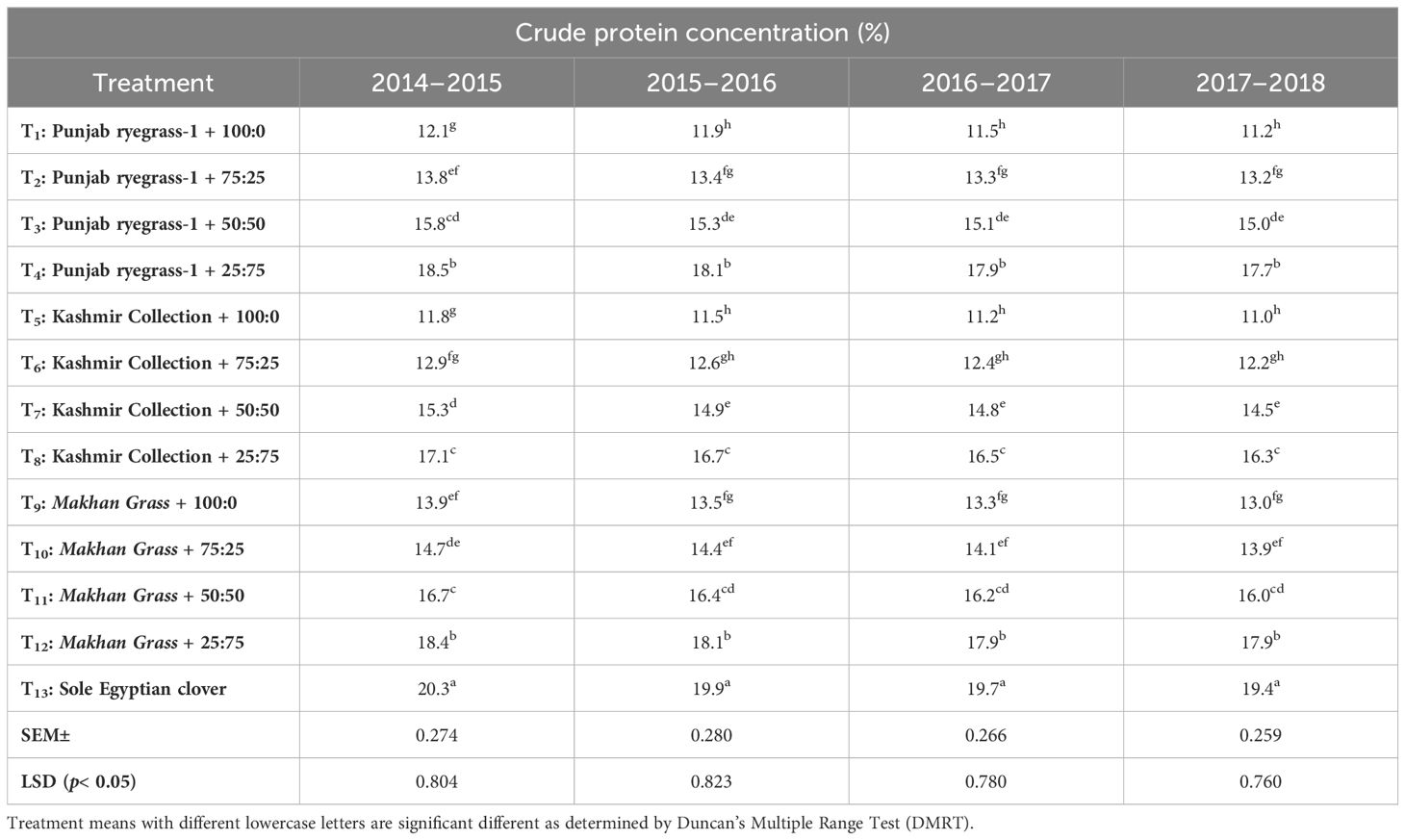
Table 4 Effect of seeding ratios and Italian ryegrass genotypes on crude protein concentration from 2014 to 2018.
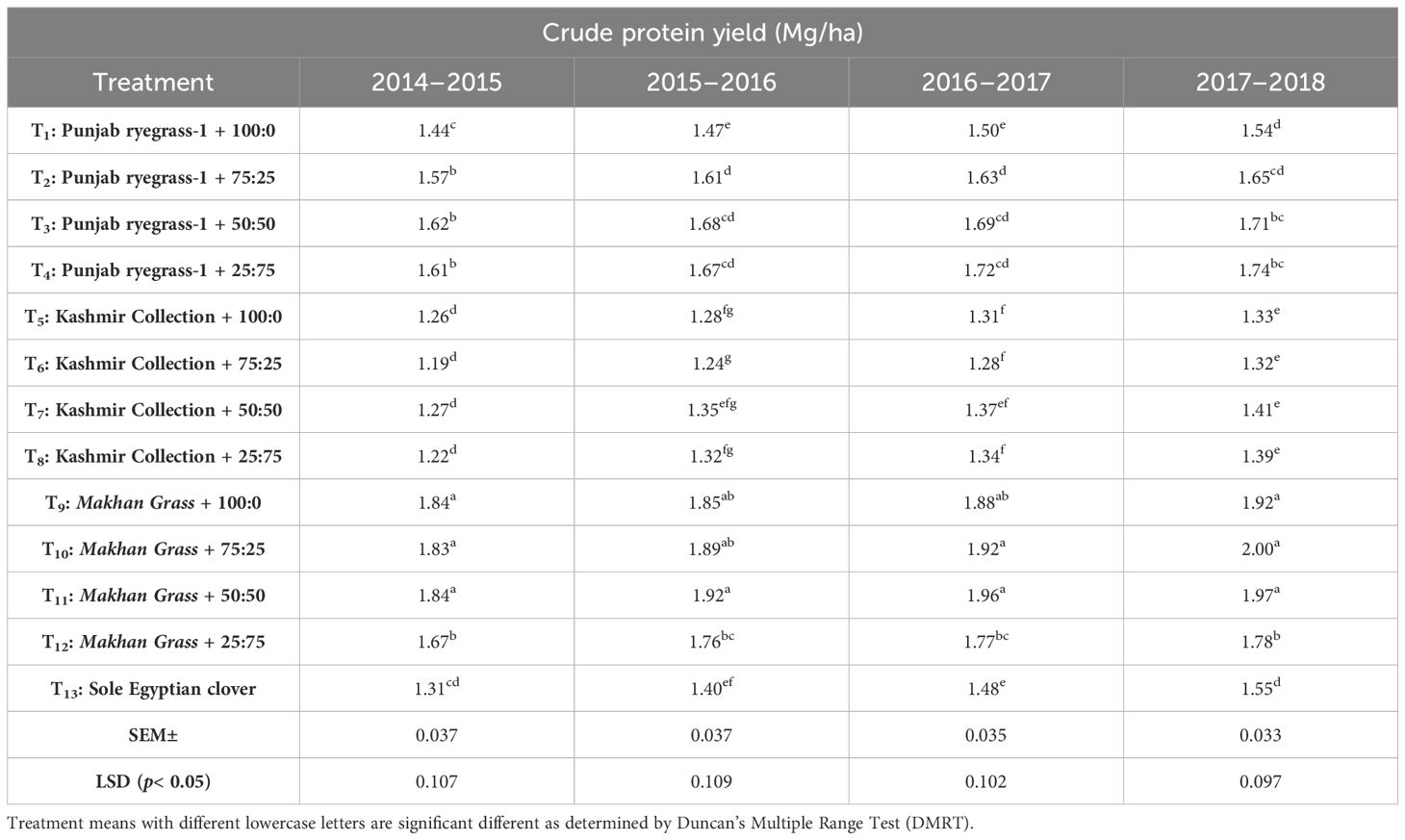
Table 5 Effect of seeding ratios and Italian ryegrass genotypes on crude protein yield from 2014 to 2018.
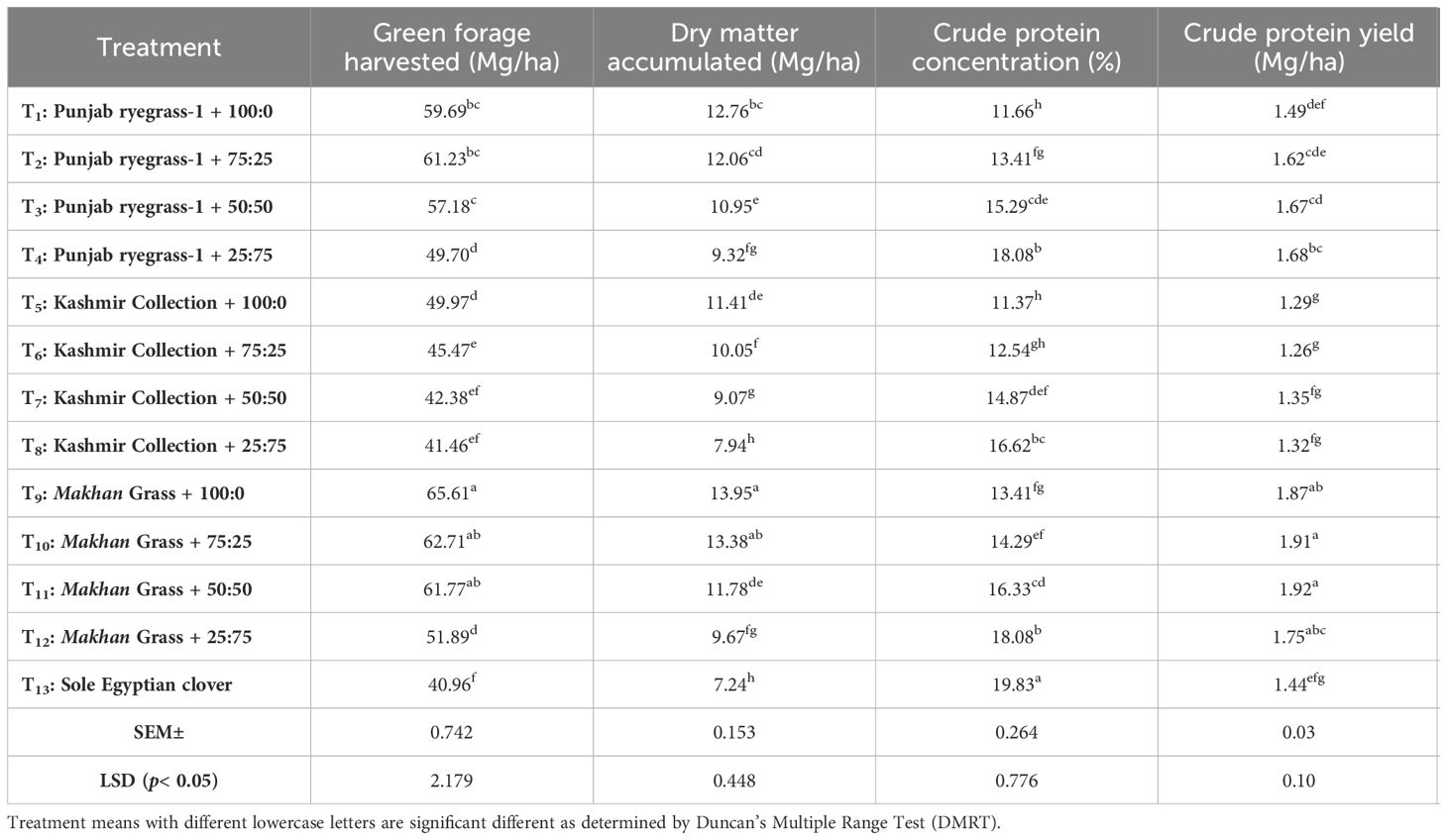
Table 6 Effect of seeding ratios and Italian ryegrass genotypes on total green forage harvested, dry matter accumulated, crude protein concentration, and yield.
3.3 Effect of seeding ratios and Italian ryegrass genotypes on soil organic carbon and available nitrogen
The exclusive cultivation of either Egyptian clover or Italian ryegrass genotypes, as well as their various combinations across diverse seeding ratios, exhibited no discernible impact on soil organic carbon levels. Conversely, the presence of distinct treatment combinations exerted a pronounced influence on soil available nitrogen content, with values ranging from 218.25 to 246.75 kg/ha. Notably, a statistically significant increase in available nitrogen content, reaching 246.75 kg/ha, was observed in the sole stand of Egyptian clover. This finding was at par with comparable levels achieved in the combinations featuring higher proportions of Egyptian clover, namely, Punjab ryegrass-1 (25:75), Kashmir collection (25:75), and Makhan grass (25:75), recording available nitrogen levels of 242.25, 232.58, and 237.83 kg/ha, respectively. Conversely, the lowest available nitrogen content of 218.25 kg/ha manifested in the sole stand of the Italian ryegrass genotype, i.e., Punjab ryegrass-1. This result demonstrated statistical parity with the exclusive stands of the Kashmir collection and Makhan grass (Table 7).
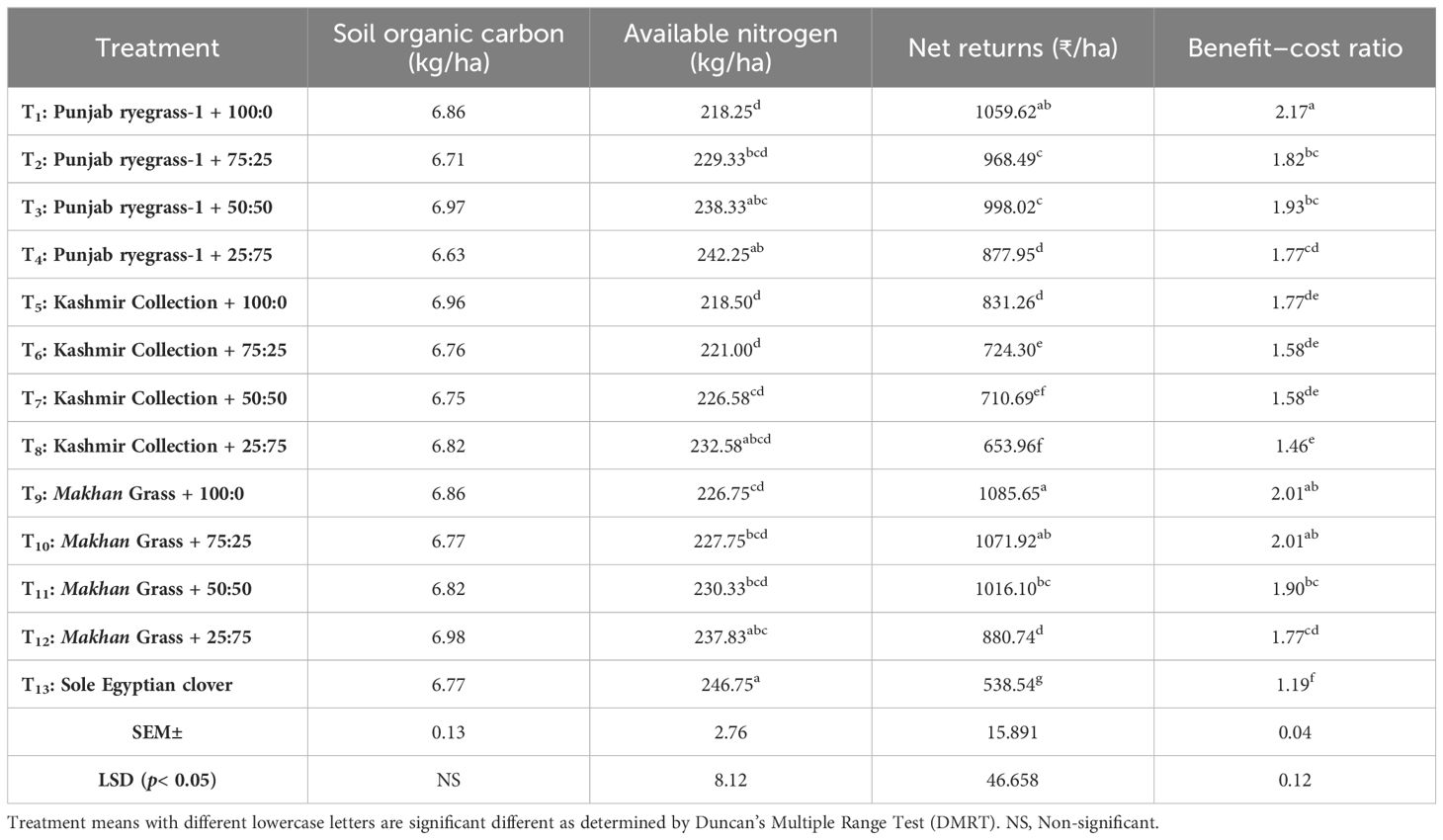
Table 7 Effect of seeding ratios and Italian ryegrass genotypes on soil organic carbon, available nitrogen, net returns, and benefit–cost ratio.
3.4 Effect of seeding ratios and Italian ryegrass genotypes on economics
Net returns exhibited a range from 538.54 USD/ha to 1,085.65 USD/ha, while the benefit–cost ratios spanned from 1.19 to 2.17. These variations were observed in response to the combinations of Egyptian clover and genotypes of Italian ryegrass cultivated under diverse seeding ratios, as detailed in Table 7. The highest net returns, amounting to 1,085.65 USD/ha, were achieved through the sole cultivation of the Italian ryegrass genotype, Makhan grass. This performance was statistically comparable to the sole cultivation of Punjab ryegrass-1 (1059.62 USD) and the co-cultivation of Makhan grass and Egyptian clover at seeding ratios of 75:25 (1071.92 USD/ha). Assessing the benefit–cost ratio, the sole cultivation of the Punjab ryegrass-1 genotype emerged as the most economically efficient, attaining a ratio of 2.17. This performance was statistically at par with the sole stand of Makhan grass (2.01) and the combination of Makhan grass with Egyptian clover at a seeding ratio of 75:25 (2.01). Conversely, the exclusive cultivation of Egyptian clover yielded the lowest net returns of 538.54 USD/ha, accompanied by a benefit–cost ratio of 1.19.
3.5 Effect of seeding ratios and Italian ryegrass genotypes on competition indices
3.5.1 Land equivalent ratio
The value of LER for Italian ryegrass ranged from 0.43 to 0.83 and that for Egyptian clover spanned from 0.25 to 0.59, whereas the total LER ranged from 0.92 to 1.11 (Figure 1). The highest LER in terms of Egyptian clover was evaluated with the co-cultivation of Punjab ryegrass-1 and Egyptian clover with a seeding ratio of 25:75 (0.59), and the lowest LER was evaluated with the combination of Makhan grass and Egyptian clover with a seeding ratio of 75:25 (0.25). The corresponding values in terms of Italian ryegrass were obtained with the co-cultivation of Punjab ryegrass-1 and Egyptian clover with seed ratios of 75:25 (0.83) and 25:75 (0.43). The highest total LER of 1.11 was with the combination of Punjab ryegrass-1 and Egyptian clover with seeding ratios of 75:25 and 50:50, whereas the lowest total LER of 0.92 was with the combination of Kashmir collection and Egyptian clover at a seed ratio of 50:50.
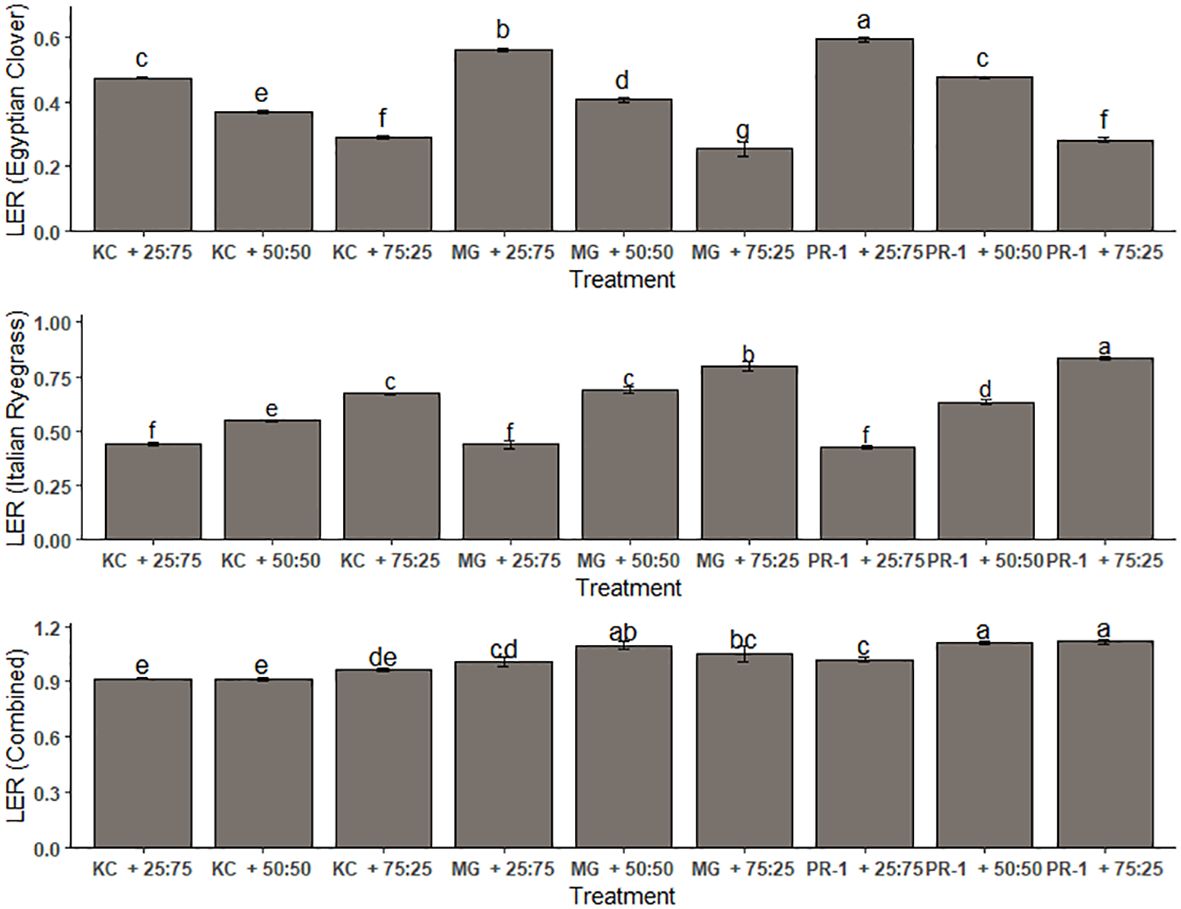
Figure 1 Effect of seeding ratios and Italian ryegrass genotypes on land equivalent ratio (LER). Different lowercase letters define significant differences among treatment means as determined by Duncan’s Multiple Range Test (DMRT).
3.5.2 Competitive ratio
The combination of seeding ratios and Italian ryegrass genotypes influenced Egyptian clover CR values significantly, which ranged from 0.43 to 1.30, while for Italian ryegrass, it spanned between 0.77 and 2.80 (Figure 2). The range itself presented high competitiveness of Italian ryegrass in comparison to its companion crop Egyptian clover. The highest CR of 2.80 with respect to Italian ryegrass was observed with the Kashmir collection in combination with Egyptian clover having a seeding ratio of 25:75, while with respect to Egyptian clover, the highest CR of 1.30 was with the combination of the Kashmir collection and Egyptian clover but with a seeding ratio of 75:25. The lowest CR of 0.43 with respect to Egyptian clover was evaluated with the co-cultivation of Makhan grass and Egyptian clover with a seeding ratio of 25:75, whereas the lowest CR of 0.77 in terms of Italian ryegrass was evaluated with the co-cultivation of the Kashmir collection with a seed ratio of 75:25.
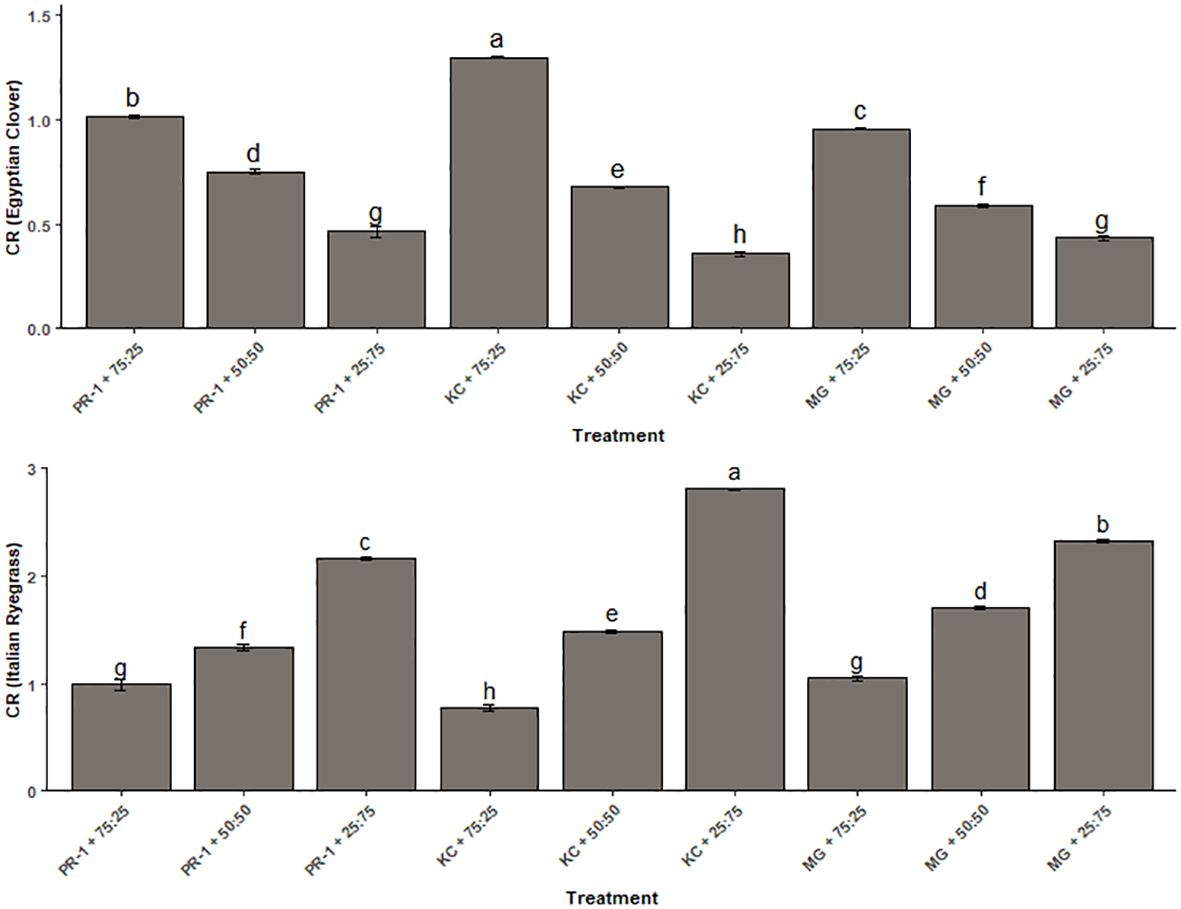
Figure 2 Effect of seeding ratios and Italian ryegrass genotypes on crop competitive ratios. Different lowercase letters define significant differences among treatment means as determined by Duncan’s Multiple Range Test (DMRT).
3.5.3 Relative crowding coefficient
The value of K for Italian ryegrass ranged from 0.68 to 2.38; for Egyptian clover, it spanned from 0.30 to 1.23, whereas the total K ranged from 0.70 to 2.04 (Figure 3). The highest and lowest K in terms of Egyptian clover were evaluated with the co-cultivation of the Kashmir collection and Egyptian clover with seeding ratios of 75:25 (1.23) and 25:75 (0.30), respectively. The corresponding values in terms of Italian ryegrass were obtained with the co-cultivation of the Kashmir collection and Egyptian clover with seed ratios of 25:75 (2.38) and 75:25 (0.68). The highest total K of 2.04 was with the combination of Punjab ryegrass-1 and Egyptian clover with a seeding ratio of 75:25, whereas the lowest total K of 0.70 was with the combination of the Kashmir collection and Egyptian clover at a seed ratio of 50:50.
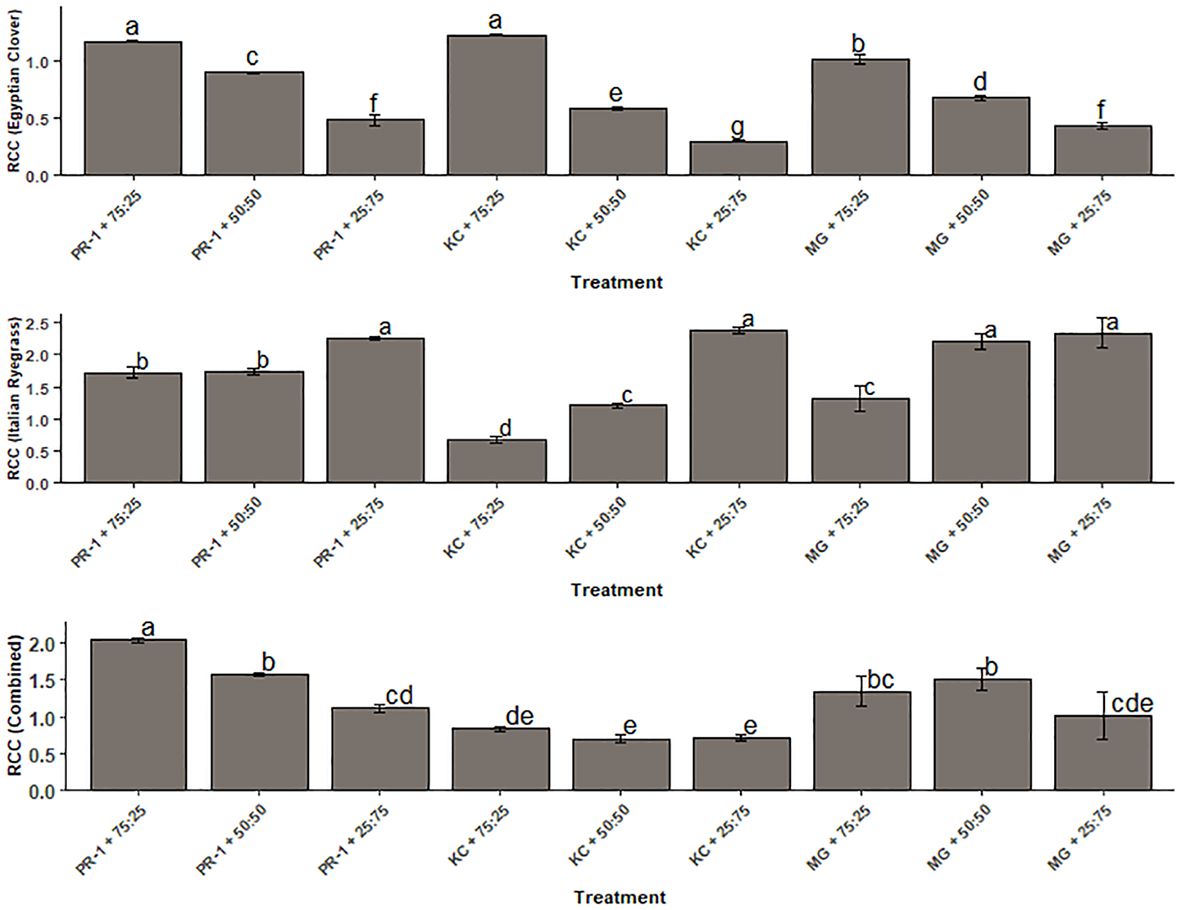
Figure 3 Effect of seeding ratios and Italian ryegrass genotypes on relative crowding coefficient (K). Different lowercase letters define significant differences among treatment means as determined by Duncan’s Multiple Range Test (DMRT).
3.5.4 Actual yield loss
The value of AYL for Italian ryegrass ranged from −0.10 to 0.77; for Egyptian clover, it spanned from −0.37 to 0.16, whereas the total AYL ranged from −0.17 to 0.50 (Figure 4). The highest and lowest AYL in terms of Egyptian clover were evaluated with the co-cultivation of the Kashmir collection and Egyptian clover with seeding ratios of 75:25 (0.16) and 25:75 (−0.37), respectively. The corresponding values in terms of Italian ryegrass were obtained with the co-cultivation of Kashmir collection and Egyptian clover with seed ratios of 25:75 (0.77) and 75:25 (−0.10). The highest total AYL of 0.50 was with the combination of Makhan grass with Egyptian clover with a seeding ratio of 25:75, whereas the lowest total AYL of −0.17 was with the combination of the Kashmir collection and Egyptian clover at a seed ratio of 50:50.
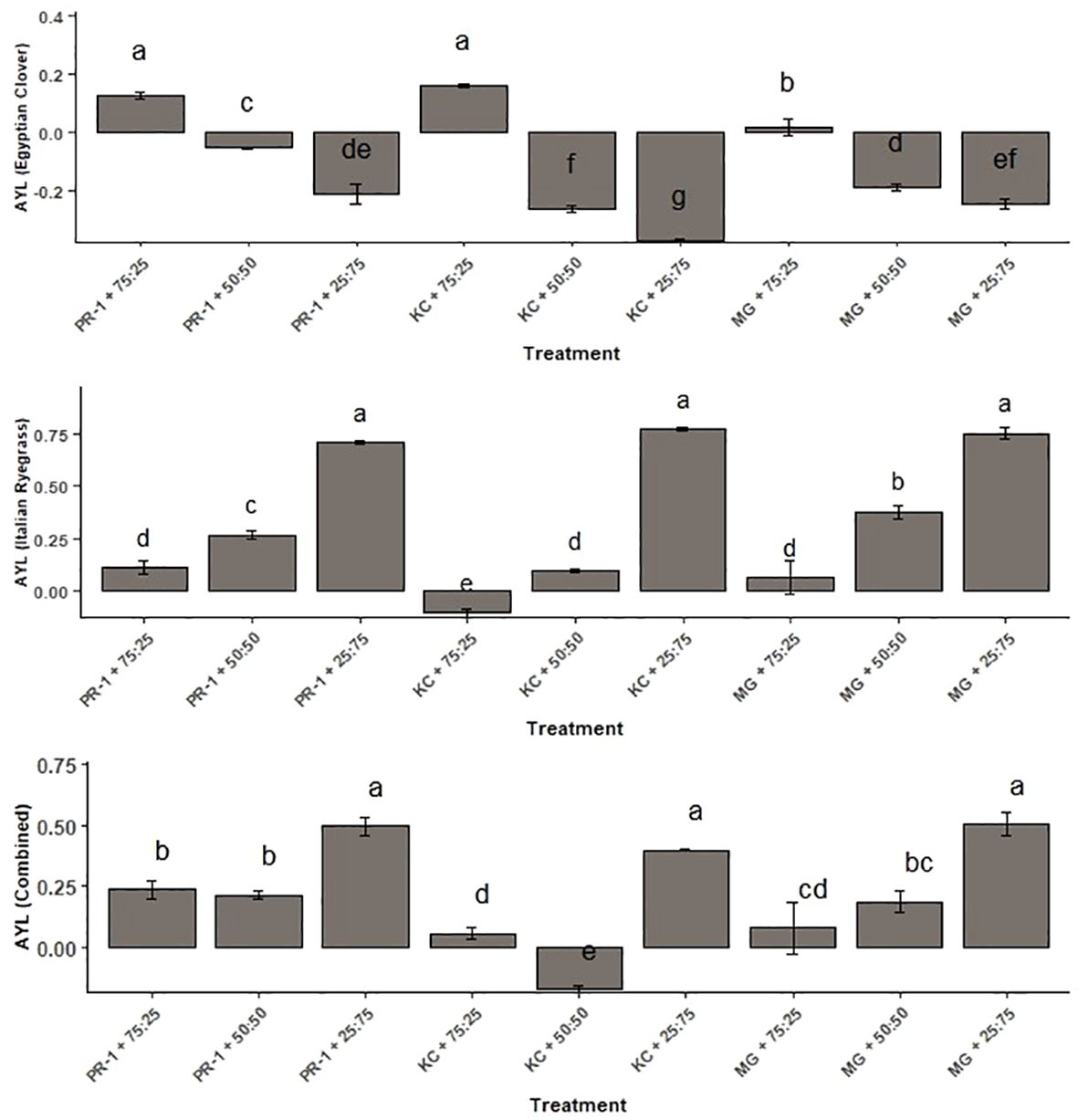
Figure 4 Effect of seeding ratios and Italian ryegrass genotypes on the actual yield loss (AYL). Different lowercase letters define significant differences among treatment means as determined by Duncan’s Multiple Range Test (DMRT).
3.6 Correlation analysis between harvest, quality parameters, and competitive indices
The results for the correlation are represented in Figure 5. The forage harvest parameters were found to be positively correlated among each other. This suggests that an increase in one of the parameters would result in an increase of the other. Total forage harvested (TFH) was found to be strongly correlated to dry matter yield (DMY) (r = 0.925) and crude protein yield (CPY) (r = 0.785), whereas moderate correlation between dry matter accumulation and crude protein yield was observed (r = 0.567). In regard to the competitive indices, moderate correlation was observed between TFH and AYL (total) (r = 0.458) as well as for CPY and AYL (combined) (r = 0.490). As expected, CPC showed a negative correlation with DMA (r = −0.676) but a positive correlation with available soil nitrogen (0.933). The above results clearly state a scenario of decreasing CPC with increase in DMA in cropping mixtures. Available nitrogen with a positive relationship with CPC states that with the increase in soil available nitrogen, plants will surely have an increased CPC in their dry matter. A moderate but a negative correlation was observed within AN and DMA (r = 0.574).
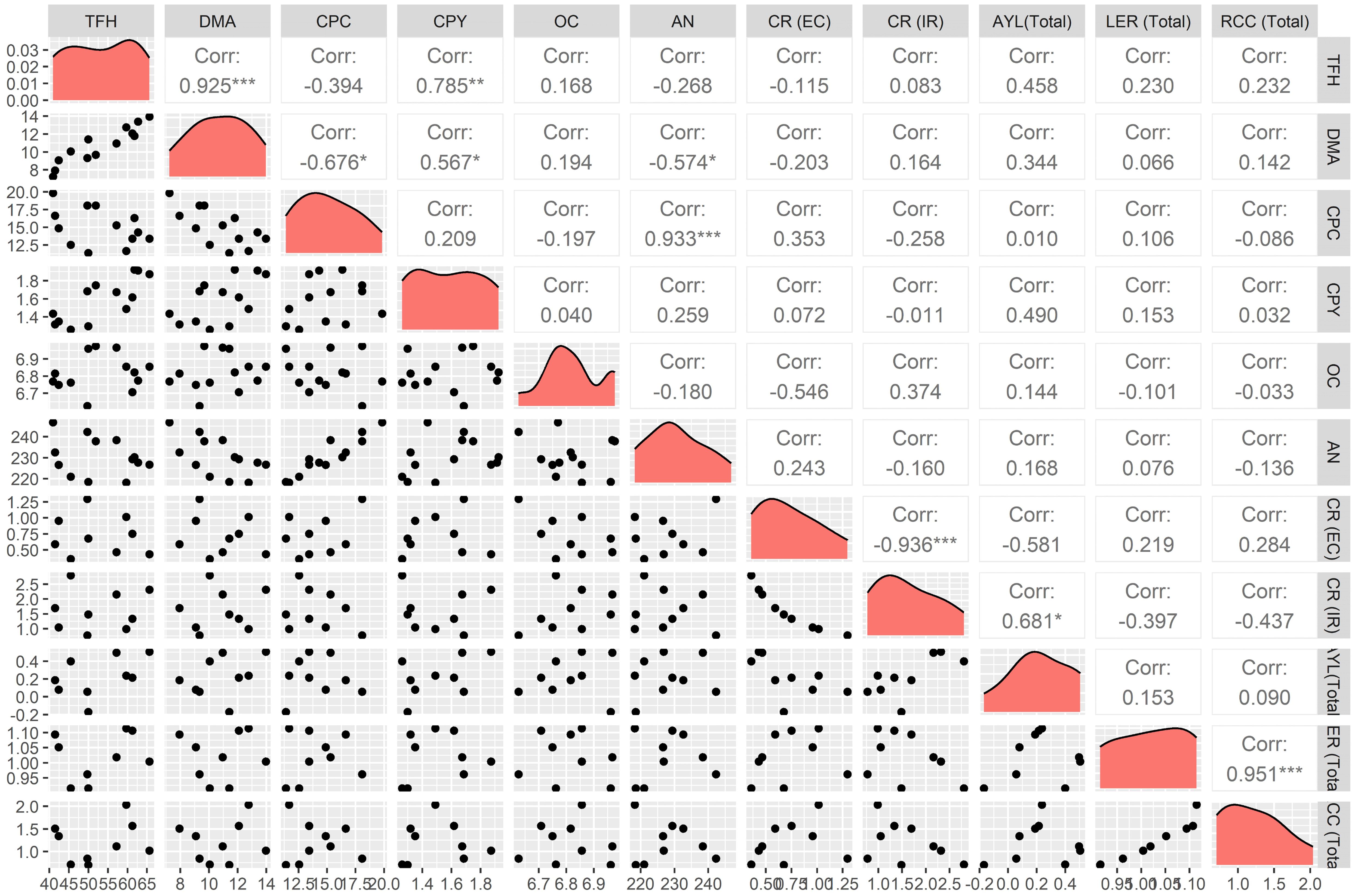
Figure 5 Correlation studies among TFH, DMA, CPC, CPY, competitive indices, and soil properties. DMA, Dry Matter Accumulation (Mg/ha); TFH, Total Forage Harvest (Mg/ha); CPY, Crude Protein Yield (Mg/ha); RCC (Combined), relative crowing coefficient (combined); LER, Land Equivalent Ratio (Combined); AYL (Combined), Actual Yield Loss (Combined); CR (IR), competitive ratio (Italian ryegrass); OC, organic carbon (kg/ha); AN, Available Nitrogen (kg/ha); CPC, Crude Protein Concentration (%); and CR (EC), Competitive ratio (Egyptian Clover). *, **, and *** represent significance at p-values of 0.05, 0.01, and 0.001, respectively.
4 Discussion
The forage grasses have been known to have considerably higher forage producing capacity. The potential of Italian ryegrass to produce significantly higher dry matter or forage harvest could be attributed to its robust photosynthetic capacity (Helmy et al., 2011). A notable decline in the forage harvested is observed when the seeding fraction of Italian ryegrass is reduced from 100 to 25. This discernible reduction in forage harvest may be attributed to the inherent higher harvest potential of grasses in contrast to leguminous counterparts (Bacchi et al., 2021). A field investigation by Bacchi et al. (2021) reported similar outcomes wherein grasses outperformed legumes in terms of total forage harvest and dry matter accumulation. Similarly, Prajapati and his co-workers in 2020 (Prajapati et al., 2020) reported that the sole ryegrass stand had a considerably higher forage harvest as compared to the sole stand of Egyptian clover. Furthermore, it was reiterated that intercropping systems of Italian ryegrass and Egyptian clover outperform monocultures of Egyptian culture in terms of forage harvest and dry matter accumulation. Monocultures of Italian ryegrass performed at par with the cropping mixtures of Italian ryegrass and clover (Prajapati et al., 2020). The variation in dry matter accumulated can be ascribed to the seeding proportions of Italian ryegrass and Egyptian clover, and green forage harvest for the various combinations. Higher green forage harvest with the sole stand of Italian ryegrass resulted in higher dry matter accumulation. The findings are in conformity with the research conducted by Yucel et al. (2018).
The capacity to fix atmospheric nitrogen by leguminous plants augments the protein concentration within the plants (Salama, 2020). In the present investigation, increase in the seeding proportion of leguminous Egyptian clover while co-cultivating with Italian ryegrass enhanced the crude protein concentration, which aligns with the findings of Prajapati et al. (2020). The pragmatic approach to compensate for high-quality forage would be to mix leguminous crops and grasses in right proportions. Crude protein yield is a function of dry matter accumulated and crude protein concentration; hence, low dry matter accumulation would result in decline in crude protein yield. The profitability of the various treatments was proportional to the green forage production of the forage combination. The sole stand of Italian ryegrass, i.e., Punjab ryegrass-1, had a better benefit–cost ratio and net returns. As discussed previously, the nitrogen-fixing ability inherent in leguminous crops, i.e., Egyptian clover, extends beyond its role in elevating crude protein concentration within forage blends. Significantly, this biological process contributes to the improvement of nitrogen availability in the soil, thereby nurturing a conducive environment for enhanced agricultural productivity. This dual functionality, encompassing both nutritional improvement in forage crops and soil nitrogen enhancement, emphasizes the multifaceted contributions of leguminous crops to sustainable agronomic practices.
The CR for Italian ryegrass was found to be considerably greater than that of its component crop, Egyptian clover, indicating that Italian ryegrass is a more competitive crop in forage combinations (Dhima et al., 2007). In the present investigation, intraspecific rivalry among crops had a stronger impact on competitive abilities. Increased seeding proportion led to increased intraspecific competition for both Italian ryegrass and Egyptian clover, negatively affecting their CR. With a drop in Italian ryegrass sowing proportion or a rise in legume crop sowing ratio, Egyptian clover CR declined whereas lowering the fraction of Egyptian clover sown had a favorable effect on CR (Egyptian clover). Makhan grass’s stronger producing capacity and aggressive growth habit resulted in much higher CR (rye) values for ryegrass and lower CR values for Egyptian clover. With its slower growth, the Kashmir collection allowed Egyptian clover to flourish at a considerable rate and compete with Italian ryegrass.
Except at 25:75 seeding ratio, Italian ryegrass showed partial LER values larger than 0.5 and yield advantage at different sowing ratios and genotypes. Total land equivalent ratios greater than 1 indicated that the forage blends had a yield advantage. Such LER values demonstrated the ability of grass–legume mixes to provide greater yield than their mono-cropping counterparts (Bedoussac and Justes, 2010; Vlachostergios et al., 2018). It has been found that grass–legume combinations may efficiently use environmental and land resources (Dhima et al., 2014). In comparison to Punjab Ryegrass-1 and 75:25 seeding proportion-based co-cultivation, sole cropping would have required 1.114 times more land area to yield the same amount of forage harvest, whereas sole cropping with a Punjab Ryegrass-based 50:50 seeding ratio would require 1.107 times more space to produce the same amount of harvest. Among genotypes, Makhan grass combination with Egyptian clover performed equivalent to the co-cultivated Punjab ryegrass-1 and Egyptian clover but much better than the sole stand of Egyptian clover in terms of resource use. K (ryegrass) was found to be considerably higher than K (Egyptian clover), indicating that Italian ryegrass is a more competitive crop than Egyptian clover. Most of the K (Egyptian clover) values under the impact of combinations of genotypes and seeding proportions were less than 1, suggesting that the relevant treatments had a yield disadvantage (Willey and Rao, 1980; Ghosh, 2004). Except for the Kashmir collection genotype with 75:25 planting percentage, K (ryegrass) values were typically more than 1, indicating a yield advantage (Banik et al., 2000).
Partial AYL values for Italian ryegrass demonstrated a clear yield benefit for the crop when Egyptian clover was included (Rady, 2016). As the seeding ratio of Egyptian clover was increased, the yield advantage of Italian ryegrass rose. This was mostly due to Egyptian clover’s capacity to fix atmospheric nitrogen, which may be efficiently absorbed by partner cereals/grasses and supplied to soil following the breakdown of legume biomass. Italian ryegrass was also found to have yield advantages over Egyptian clover. Banik et al. (2000) also observed that Italian ryegrass was extending yield advantages to Egyptian clover. However, the yield advantage was continually decreasing as the fraction of Egyptian clover sowing rose, mostly due to intraspecific competition with Egyptian clover plants. Among genotypes, Makhan grass’s better yielding potential provided much bigger yield benefits to Italian ryegrass and significantly lesser advantages to Egyptian clover.
5 Conclusion
With their great photosynthetic efficiency, grasses contribute significantly to the world livestock’s feed supply. However, giving animals low-quality feed, particularly in terms of protein concentration, has a detrimental influence on livestock output. Forage combinations based on grass and legumes can help to overcome the problem of low-quality feed. Grass genotypes and grass–legume-based seeding ratios, with widely varied dry matter contributions, have a substantial impact on the productivity, profitability, and nutritive value of forage combinations. Experiment results with Italian ryegrass genotypes and Italian ryegrass: Egyptian clover seeding ratios over the years revealed that mixed planting of Italian ryegrass and Egyptian clover was the best option for supplying excellent forage. Although sole stands of the Italian ryegrass genotype, i.e., Makhan grass, led to 60% more forage harvests compared to the sole stand of Egyptian clover followed by cropping mixtures with Egyptian clover at seeding ratios of 75:25 (53% yield increment) and 50:50 (51% yield increment), the nutritive value in terms of crude protein yield was considerably higher for 50:50 and 75:25 seeding ratios of Italian ryegrass and Egyptian clover, i.e., approximately 33% and 30% higher crude protein yield compared to the sole stand of Egyptian clover. Owing to substantially higher forage harvests, Italian ryegrass alone proved far more lucrative than mixed forage stands of Italian ryegrass and Egyptian clover. Over time, an increased amount of Egyptian clover had a favorable impact on soil fertility. Makhan grass outperformed other genotypes and proved to be the most productive and profitable among them. In terms of forage output and revenue generation, the optimum seeding ratio and genotype combination was Makhan grass with a 100:0 seeding ratio with almost double the net returns as compared to returns generated from the sole stand of Egyptian clover. Thus, the 100:0 planting ratio with Makhan grass is the best choice for increased productivity and profitability, although a 75:25 seeding ratio with Makhan grass might be a reasonable alternative in terms of quality feed and soil fertility. According to competition indices such as CR and relative crowding coefficient, Italian ryegrass was a moderately competitive crop and Egyptian clover was a relatively dominating crop. AYL values confirmed the complementary relationship between grasses and legumes, with Egyptian clover having significantly higher AYL values and yield advantage at 75:25 seeding proportion, whereas Italian ryegrass had it at 25:75 seeding proportion, i.e., with higher legume inclusion.
Data availability statement
The original contributions presented in the study are included in the article/Supplementary Material. Further inquiries can be directed to the corresponding author.
Author contributions
NK: Conceptualization, Methodology, Project administration, Writing – review & editing. RS: Conceptualization, Investigation, Methodology, Writing – review & editing. RA: Conceptualization, Methodology, Project administration, Writing – review & editing. GS: Conceptualization, Methodology, Project administration, Writing – review & editing. AS: Formal analysis, Writing – review & editing. TS: Formal analysis, Writing – original draft. RR: Funding acquisition, Writing – review & editing.
Funding
The publication of the manuscript was completely funded under the grant received through National Agricultural Higher Education Project (NAHEP) - Centre of Advanced Agricultural Science & Technology (CAAST)- Protected Agriculture and Natural Farming (PANF), CSKHPKV, Palampur. The authors declare that the research was conducted under the All India Coordinated Research Project on Forage Crops and Utilization.
Conflict of interest
The authors declare that the research was conducted in the absence of any commercial or financial relationships that could be construed as a potential conflict of interest.
Publisher’s note
All claims expressed in this article are solely those of the authors and do not necessarily represent those of their affiliated organizations, or those of the publisher, the editors and the reviewers. Any product that may be evaluated in this article, or claim that may be made by its manufacturer, is not guaranteed or endorsed by the publisher.
Supplementary material
The Supplementary Material for this article can be found online at: https://www.frontiersin.org/articles/10.3389/fpls.2024.1346936/full#supplementary-material
References
Abuzaid, A. S., Jahin, H. S., Asaad, A. A., Fadl, M. E., Abdel-Rahman, M. A. E., Scopa, A. (2021). Accumulation of potentially toxic metals in Egyptian alluvial soils, berseem clover (Trifolium alexandrinum L.), and groundwater after long-term wastewater irrigation. Agriculture 11, 713. doi: 10.3390/agriculture11080713
Ansar, M., Ahmed., Z. I., Malik, M. A., Nadeem, M., Majeed, A., Rischkowsky, B. A. (2010). Forage yield and quality potential of winter cereal-vetch mixtures under rainfed conditions. Emir. J. Food Agric. 22, 25–36. doi: 10.9755/ejfa.v22i1.4904
Atis, I., Kokten, K., Hatipoglu, R., Yilmaz, S., Atak, M., Can, E. (2012). Plant density and mixture ratio effects on the competition between common vetch and wheat. Aust. J. Crop Sci. 6, 498–505. doi: 10.3316/informit.361152491131442
Auguie, B., Antonov, A. (2017). gridExtra: Miscellaneous Functions for “Grid” Graphics. Available online at: https://CRAN.R-project.org/package=gridExtra.
Bacchi, M., Monti, M., Calvi, A., Presti, E. L., Pellicanò, A., Preiti, G. (2021). Forage potential of cereal/legume intercrops: agronomic performances, yield, quality forage and LER intwo harvesting times in a Mediterranean environment. Agronomy 11, 121. doi: 10.3390/agronomy11010121
Banik, P. (1996). Evaluation of wheat (T. aestivum) and legume intercropping under 1:1 and 2:1 row-replacement series system. J. Agron. Crop Sci. 176, 289–294. doi: 10.1111/j.1439-037X.1996.tb00473.x
Banik, P., Sasmal, T., Ghosal, P. K., Bagchi, D. K. (2000). Evaluation of mustard (Brassica campestris var. Toria) and legume intercropping under 1:1 and 2:1 row-replacement series systems. J. Agron. Crop Sci. 185, 9–14. doi: 10.1046/j.1439-037X.2000.00388.x
Bedoussac, L., Justes, E. (2010). Dynamic analysis of competition and complementarity for light and N use to understand the yield and the protein content of a durum wheat-winter pea intercrop. Plant Soil. 330, 37–54. doi: 10.1007/s11104-010-0303-8
Devi, U. (2019). Satpal. Performance of berseem (Trifolium alexandrium L.) genotypes at different phosphorus levels. Forage Res. 44, 260–263.
Dhima, K. V., Lithourgidis, A. S., Vasilakoglou, I. B., Dordas, C. A. (2007). Competition indices of common vetch and cereal intercrops in two seeding ratio. Field Crops Res. 100, 249–256. doi: 10.1016/j.fcr.2006.07.008
Dhima, K. V., Vasilakoglou, I. B., Keco, R. X., Dima, A. K., Paschalidis, K. A., Gatsis, T. D. (2014). Forage yield and competition indices of faba bean intercropped with oat. Grass Forage Sci. 69, 376–383. doi: 10.1111/gfs.12084
Felipe, De, M. (2009). Una herramienta de analisis estadistico para la investigacion Agricola. Universidad Nacional de Ingenieria (Rímac District, Peru: UNI-PERU).
Gerdes, L., Mattos, H. B. D., Werner, J. C., Colozza, M. T., Cunha, E. A. D., Bueno, M. S., et al. (2005). Chemical composition and digestibility of forage mass in irrigated aruanagrass pastures or oversown with a mixture of winter forage species. Rev. Bras. Zootec. 34, 1098–1108. doi: 10.1590/S1516-35982005000400003
Ghosh, P. K. (2004). Growth, yield, competition and economics of groundnut/cereal forage intercropping systems in the semi-arid tropics of India. Field Crops Res. 88, 227–237. doi: 10.1016/j.fcr.2004.01.015
Hannaway, D., Fransen, S., Cropper, J., Teel, M., Chaney, M., Griggs, T., et al. (1999). Annual ryegrass (Lolium multiflorum Lam.), State University. Extension Service, O., State University. Cooperative Extension, W., of Idaho. Cooperative Extension Service, U., & Northwest Cooperative Extension, P. United States of America: [Corvallis, Or.]: Oregon State University Extension Service, [Pullman, Wash.]: Washington State University Cooperative Extension, [Moscow, Idaho]: University ofIdaho Cooperative Extension Service.
Helmy, A. A., Wafaa, M. S., Hoda, I. M. T. (2011). Evaluation of forage yield and its quality of barley and berseem and ryegrass sown alone on intercropped with berseem clover. J. Plant Prod. 2, 851–863. doi: 10.21608/JPP.2011.85620
Jabbar, A., Iqbal, A., Iqbal, M. A., Sheikh, U. A. A., Rahim, J., Khalid, S. (2022). Egyptian clover genotypic divergence and last cutting management augment nutritive quality, seed yield and milk productivity. Sustainability 14, 5833. doi: 10.3390/su14105833
Jackson, M. L. (1973). Soil Chemical Analysis (Englewood Cliffs, New Jersey, USA: Prentice Hall Inc).
Kushwaha, M., Singh, J. (2023). Improved agronomic practices for the cultivation of ryegrass. Indian Farming 73, 21–23.
Lithourgidis, A. S., Dordas, C. A., Damalas, C. A., Vlachostergios, D. (2011). Annual intercrops: an alternative pathway for sustainable agriculture. Aust. J. Crop Sci. 5, 396–410.
Lithourgidis, A. S., Vasilakoglou, I. B., Dhima, K. V., Dordas, C. A., Yiakoulaki, M. D. (2006). Forage yield and quality of common vetch mixtures with oat and triticale in two seeding ratios. Field Crops Res. 99, 106–113. doi: 10.1016/j.fcr.2006.03.008
Magda, N. R., Walaa, M. E. M., Abd El-Monem, A. M. A. (2021). Yield and quality of Egyptian clover and ryegrass mixtures under nitrogen levels and bio-fertilizer. J. Am. Sci. 17, 74–88. doi: 10.7537/marsjas190521.09
Mead, R., Willey, R. W. (1980). The concept of a land equivalent ratio and advantages in yields for intercropping. Exp. Agric. 16, 217–228. doi: 10.1017/S0014479700010978
Meena, H., Narolia, R. S., Singh, P., Meena, P. K. P., Kumhar, B. L. (2017). Performance of Makhan grass (Lolium multiflorum) under various seed rate in South East Rajasthan, India. Int. J. Curr. Microbiol. Appl. Sci. 6, 1945–1950. doi: 10.20546/ijcmas.2017.605.216
Olsen, S. R., Cole, C. W., Watanable, F. S., Dean, L. A. (1954). Estimation of available phosphorus in soils by extraction with NaHCO3. United States Department Agric. Circular 939, 19–23.
Pecetti, L., Usai, R., Romani, M., Fraschini, P., Salis, M. (2012). Evaluation of berseem clover (Trifolium alexandrinum L.) germplasm in Sardinia, Italy. Ital. J. Agron. 7, e28. doi: 10.4081/ija.2012.e28
Prajapati, B., Tiwari, S., Kumar, K. (2020). Effect of forage based intercropping systems on herbage yield and quality of forage under tarai region of Uttarakhand. Forage Res. 46, 63–68.
Rady, A. M. S. (2016). Competition indices of berseem clover, italian ryegrass mixtures. Alex. J. Agric. Res. 61, 419–428.
Rady, A. M., Attia, M. F., Kholif, A. E., Sallam, S. M., Vargas-Bello-Pérez, E. (2022). Improving fodder yields and nutritive value of some forage grasses as animal feeds through intercropping with Egyptian Clover (Trifolium alexandrinum L.). Agronomy 12, 2589. doi: 10.3390/agronomy12102589
Rakeih, N., Kayyal, H., Larbi, A., Habib, N. (2008). Forage potential of triticale in mixtures with forage legumes in rainfed regions (second and third stability zones) in Syria. Int. J. Innov. Res. Sci. Stud. 30, 203–216.
R Core Team. (2023). R: A Language and Environment for Statistical Computing (Vienna, Austria: R Foundation for Statistical Computing). Available at: https://www.R-project.org/.
Salama, H. S. A. (2020). Mixture cropping of berseem clover with cereals to improve forage yield and quality under irrigated conditions of the Mediterranean basin. Ann. Agric. Sci. 65, 159–167. doi: 10.1016/j.aoas.2020.09.001
Schloerke, B., Cook, D., Larmarange, J., Briatte, F., Marbach, M., Thoen, E., et al. (2024). GGally: Extension to 'ggplot2'. Available online at: https://ggobi.github.io/ggally/.
Subbiah, B. V., Asija, G. L. (1956). A rapid procedure for the determination of available nitrogen in soils. Curr. Sci. 25, 259–260.
Thalooth, A. T., Sary, G. A., El-Nagar, H. M., El-Kramany, M. F., Kabesh, M. O., Bakhoum, G. S. H. (2015). Yield and quality response of ryegrass, Egyptian Clover and their mixtures to different sources of fertilizers. Agric. Sci. 6, 137–145. doi: 10.4236/as.2015.61011
Tiwari, A., Singh, S., Panday, H., Rai, R. K., Maurya, R. K., Kumar, P. A. (2023). Review on response of various nitrogen levels and plant density on green forage yield, quality, and economics of makkhan grass (Lolium multiflorum L.). Int. J. Stat Appl. Mathematics 8, 314–319.
Tufail, M. S., Krebs, G. L., Southwell, A., Piltz, J. W., Norton, M. R., Wynn, P. C. (2020). Enhancing performance of berseem clover genotypes with better harvesting management through farmers’ participatory research at smallholder farms in Punjab. Sci. Rep. 10, 3545. doi: 10.1038/s41598-020-60503-7
Vlachostergios, D. N., Lithourgidis, A. S., Dordas, C. A. (2018). Agronomic, forage quality and economic advantages of red pea (Lathyrus cicera L.) intercropping with wheat and oat under low-input farming. Grass Forage Sci. 73, 777–788. doi: 10.1111/gfs.12348
Walkley, A., Black, C. A. (1934). An estimation of the method for determination of soil organic matter and a proposed modification of chromic acid titration method. Soil Sci. 37, 29–39. doi: 10.1097/00010694-193401000-00003
Wickham, H. (2016). ggplot2: Elegant Graphics for Data Analysis (New York: Springer-Verlag). Available at: https://ggplot2.tidyverse.org.
Wickham, H., François, R., Henry, L., Müller, K., Vaughan, D. (2023). dplyr: A Grammar of Data Manipulation. Available online at: https://github.com/tidyverse/dplyr.
Willey, R. W., Rao, M. R. (1980). A competitive ratio for quantifying competition between intercrops. Exp. Agric. 16, 117–125. doi: 10.1017/S0014479700010802
Keywords: Egyptian clover, forage harvest, genotypes, Italian ryegrass, mixed cropping, nutritive value, seeding ratios
Citation: Kumar N, Singh R, Agrawal RK, Sharma GD, Singh A, Sharma T and Rana RS (2024) Optimizing forage harvest and the nutritive value of Italian ryegrass-based mixed forage cropping under northwestern Himalayan conditions. Front. Plant Sci. 15:1346936. doi: 10.3389/fpls.2024.1346936
Received: 30 November 2023; Accepted: 24 May 2024;
Published: 03 July 2024.
Edited by:
Abraham J. Escobar-Gutiérrez, Institut National de Recherche pour l’Agriculture, l’Alimentation et l’Environnement (INRAE), FranceReviewed by:
Roxana Vidican, University of Agricultural Sciences and Veterinary Medicine of Cluj-Napoca, RomaniaErmias Habte Haile, International Livestock Research Institute, Ethiopia
Copyright © 2024 Kumar, Singh, Agrawal, Sharma, Singh, Sharma and Rana. This is an open-access article distributed under the terms of the Creative Commons Attribution License (CC BY). The use, distribution or reproduction in other forums is permitted, provided the original author(s) and the copyright owner(s) are credited and that the original publication in this journal is cited, in accordance with accepted academic practice. No use, distribution or reproduction is permitted which does not comply with these terms.
*Correspondence: Tarun Sharma, dGFydW5hZ3Jvbm9tb3NAZ21haWwuY29t; Ranbir Singh Rana, cnNyYW5hQGhpbGxhZ3JpYy5hYy5pbg==
 Naveen Kumar
Naveen Kumar Rajender Singh1
Rajender Singh1 Rajiv Kumar Agrawal
Rajiv Kumar Agrawal Akashdeep Singh
Akashdeep Singh Tarun Sharma
Tarun Sharma